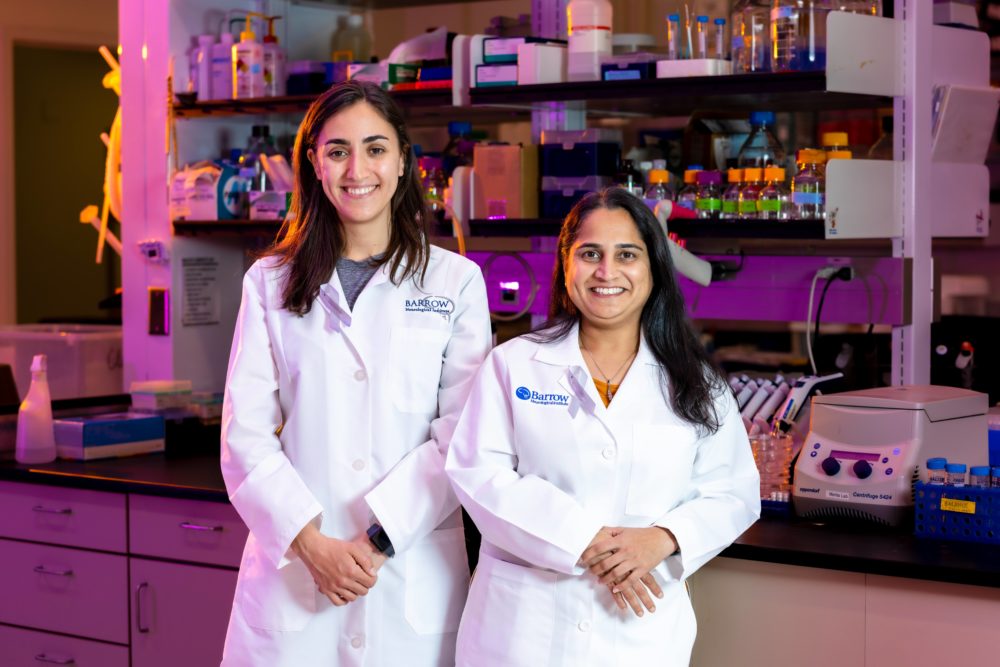
Barrow Study Suggests Important Drug Target for Glioblastoma
A new study led by Shwetal Mehta, PhD, at Barrow Neurological Institute found that a particular enzyme, known as HDAC1, may play a larger role in glioblastoma than other proteins of its kind. This finding provides rationale for developing more specific HDAC drugs to treat this highly aggressive and usually fatal brain tumor.
Glioblastoma researchers have for years viewed HDACs, or histone deacetylases, as promising therapeutic targets. However, the drugs currently available to target this family of proteins and block their function have failed to provide benefit in the clinic.
One of the reasons for this failure is that the existing HDAC drugs target multiple HDAC proteins, rather than individual enzymes, which makes these drugs highly toxic to noncancerous cells.
“We have been using drugs that target multiple enzymes without even knowing which of these individual enzymes are important for GBM biology,” said Costanza Lo Cascio, a PhD candidate working in the Mehta Laboratory and the first author on the study, published in JCI Insight. “Is one enzyme more important than the others? Are some irrelevant?”
Until now, no studies were done on the significance of HDAC1 over other HDACs in stem-like cells in glioblastoma. These cells appear to be responsible for continued tumor growth and recurrence.
The Barrow study reviewed data from patients with glioblastoma and found that their tumors had high levels of HDAC1 compared to people without the disease. It revealed another trend: the higher the levels, the worse the prognosis.
“So, there’s a correlation between HDAC1 and tumor malignancy,” Lo Cascio said.
The study compared tumors with and without the p53 gene mutation. This mutation is present in about 20 percent of patients with glioblastoma.
An Unexpected Discovery
Dr. Mehta and her team stumbled upon this finding somewhat by accident.
When she received an R01 grant from the National Institutes of Health to investigate factors that promote tumor growth, she hadn’t intended to focus on HDACs.
At the time, Dr. Mehta’s work centered on a gene called Olig2. This gene is involved in normal brain development, but it also appears to promote the formation of gliomas—tumors that arise from glial cells rather than nerve cells. Her research has shown that removing Olig2 stops glioma formation.
“My lab is primarily interested in understanding: What are the common overlapping themes between normal brain development and brain tumors?” Dr. Mehta explained. “In other words, what factors are common between the two, and what goes wrong during the normal development process to give rise to brain tumors?”
Dr. Mehta’s research also focuses on identifying and targeting factors that enable tumor cells to recur. Glioblastoma, a Grade IV glioma, poses treatment challenges because the tumor cells almost always come back—even after surgery, radiation, and chemotherapy.
While examining how Olig2 promotes tumor growth, Dr. Mehta and her team discovered that Olig2 binds with HDAC1. Furthermore, they found that removing the HDAC1 enzyme from patient-derived xenograft and mouse models also suppressed the function of Olig2.
“So we were able to achieve what we intended, just in a different way,” she said.
What Does This Mean for Patients?
While Dr. Mehta’s laboratory is still exploring the relationship between HDAC1 and Olig2, Dr. Mehta said the project adds fuel to a larger movement to create more specific HDAC drugs.
Although no other study has identified the significance of HDAC1 in stem-like cells within glioma, other reports have looked at the enzyme in different contexts.
“People are recognizing that the existing nonspecific drugs are not really working that well,” Dr. Mehta said.
Her lab is testing one drug on the market, though. While it does not specifically inhibit HDAC1, quisinostat does have a higher affinity for the enzyme than other proteins in its family.
“We’re basically using the same model that the Ivy Brain Tumor Center employs in investigating new drugs,” said Dr. Mehta, who also serves as deputy director of the Ivy Center, a phase 0 clinical trials program at Barrow. “The Ivy Center model asks: Is the drug getting into the brain or not, is it modulating its target or not, and how much of it is really needed to see an effect?”
But blocking HDAC1 alone might not be enough, she added. The study showed that knocking out the enzyme slowed tumor growth in preclinical models of glioma but did not halt it entirely.
The investigators found that the cells grow through a pathway regulated by another factor, called STAT3. Inhibitors targeting this protein are currently under development.
Dr. Mehta described the combination of HDAC and STAT3 inhibitors a promising strategy for preventing resistance mechanisms from building up.
“This paper highlights the questions we need to address before we jump into drug development and design,” Dr. Mehta said. “It also shows that we need to come up with smarter drug combinations.”

